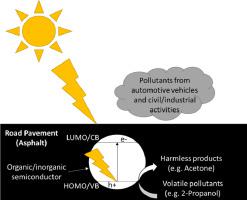Applied Materials Today ( IF 7.2 ) Pub Date : 2020-08-24 , DOI: 10.1016/j.apmt.2020.100795 Samar Al Jitan , Grzegorz Brudecki , Giovanni Palmisano , Michele Lanotte

|
In recent years, the implementation of inorganic photocatalysts in road-paving materials has been explored as a promising solution for the degradation of volatile pollutants produced by both automotive vehicles and civil/industrial activities. However, this study shows that asphalt binders, an essential component of asphalt mixtures, already possess intrinsic photocatalytic properties induced by the inorganic and organic semiconductors, which are among their numerous components. The activity of three different samples of bitumen has been assessed in comparison with that obtained on bitumen modified with TiO2 Evonik P25, a widely used inorganic photocatalyst. The activity tests have been performed towards a model volatile molecule (2-propanol) under simulated solar radiation. The activity of neat bitumen samples was significant towards the photooxidation of 2-propanol to acetone, and, surprisingly, the mass incorporation of significant amounts (5 %w/w) of TiO2 nanoparticles resulted only in a modest enhancement of its activity. These results, along with tests in aqueous phase where 4-nitrophenol and benzyl alcohol have been converted, indicate that the intrinsic activity of bitumen is of utmost relevance, despite it not being reported in previous studies. FT-IR and ICP-MS characterizations have been utilized to provide indications on the potential inorganic and organic semiconductor components being responsible for this phenomenon. AFM and TGA have provided further information on the used bitumen samples.
中文翻译:

纯净和聚合物改性沥青的光催化活性
近年来,已经探索了在铺路材料中使用无机光催化剂作为降解汽车和民用/工业活动产生的挥发性污染物的有前途的解决方案。但是,这项研究表明,沥青混合料的基本成分沥青粘合剂已经具有由无机和有机半导体诱导的内在光催化性能,而无机和有机半导体是其中的众多组分。与用TiO 2改性的沥青相比,评估了三种不同的沥青样品的活性。赢创P25,一种广泛使用的无机光催化剂。已在模拟的太阳辐射下对模型挥发性分子(2-丙醇)进行了活性测试。纯净的沥青样品的活性对于2-丙醇向丙酮的光氧化作用是显着的,并且令人惊讶的是,大量掺入(5%w / w)的TiO 2的质量纳米颗粒仅导致其活性适度增强。这些结果以及在4-硝基苯酚和苯甲醇已被转化的水相中的测试表明,沥青的内在活性具有最大的相关性,尽管以前的研究没有报道。FT-IR和ICP-MS的表征已被用于指示造成这种现象的潜在无机和有机半导体成分。AFM和TGA已提供有关所用沥青样品的更多信息。











































 京公网安备 11010802027423号
京公网安备 11010802027423号